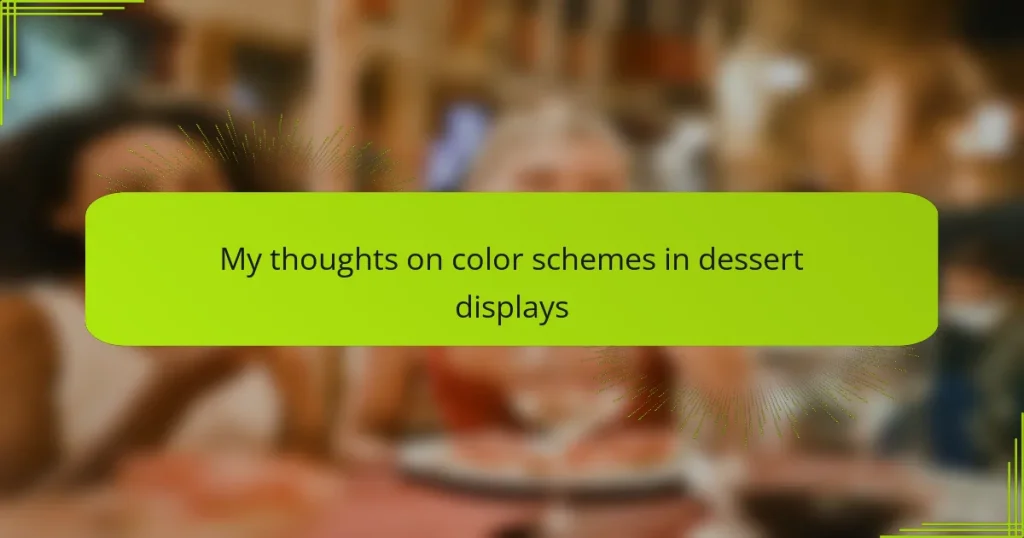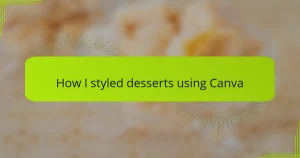Key takeaways
- Color schemes in desserts enhance visual appeal and evoke emotions, influencing guests’ expectations before tasting.
- Complementary and contrasting colors create balance, making desserts more inviting and memorable.
- Choosing colors based on dessert types and natural ingredients amplifies flavor perception and emotional connections.
- Effective dessert displays benefit from thoughtful arrangement, height variation, and subtle decorative touches to enhance overall presentation.
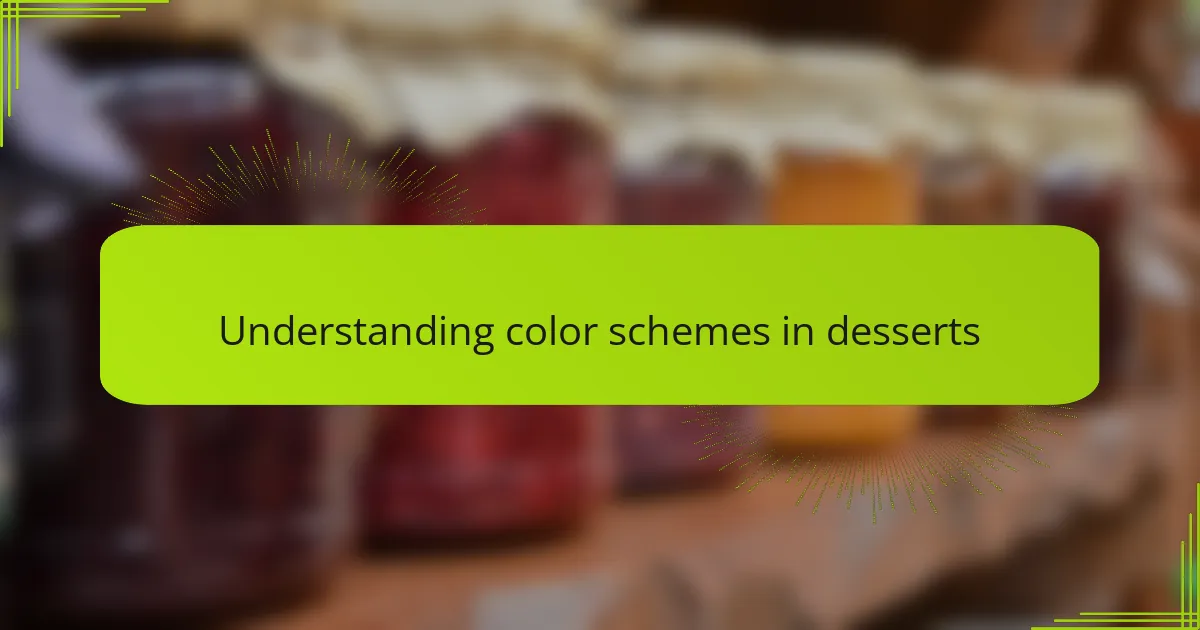
Understanding color schemes in desserts
Color schemes in desserts are more than just a visual treat; they evoke emotions and set the mood even before the first bite. I’ve noticed that when I create displays with harmonious colors, my guests seem more drawn—curious and eager to taste. Have you ever paused to wonder why certain desserts catch your eye instantly? I think it’s because color speaks a silent language that we all understand.
From my experience, complementary colors work wonders in making desserts pop on a table. Adding a touch of contrasting hues not only highlights individual treats but also brings an overall pleasing balance. It’s like painting with edible colors; knowing how to combine them effectively is as crucial as the recipe itself.
I always find myself experimenting with pastel shades in spring, feeling that they bring freshness and lightness to my display. Sometimes, I ask: do softer tones make desserts appear more delicate and inviting? For me, the answer lies in both the visual appeal and the emotions these colors inspire—comfort, joy, and a hint of nostalgia.
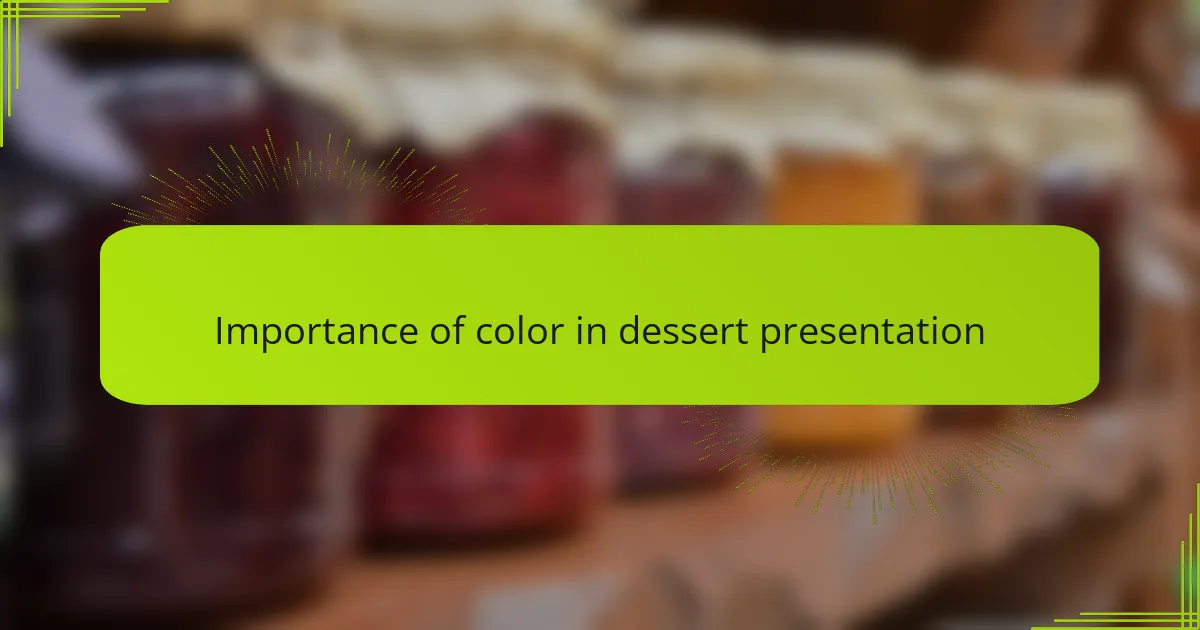
Importance of color in dessert presentation
Color plays a surprising role in dessert presentation—it can make a treat look irresistible or, honestly, quite forgettable. I’ve seen how a splash of vibrant red or a gentle swirl of lavender instantly lifts the entire display, almost like the dessert is calling out to be tasted. Isn’t it fascinating how our eyes decide what appeals to us even before our taste buds get involved?
When I arrange desserts, I pay close attention to the balance of colors. Too much of one tone can feel overwhelming, while the right mix creates harmony that’s pleasing and inviting. I often think of it like composing music—each color a note that needs to blend just right to create a melody you want to savor visually.
What strikes me most is how color influences mood at dessert tables. Bright shades spark excitement and energy, while muted tones suggest calm and elegance. I wonder if guests feel more comforted by desserts framed in warm, earthy hues? From experience, that subtle emotional nudge can turn an ordinary moment into a memorable one.
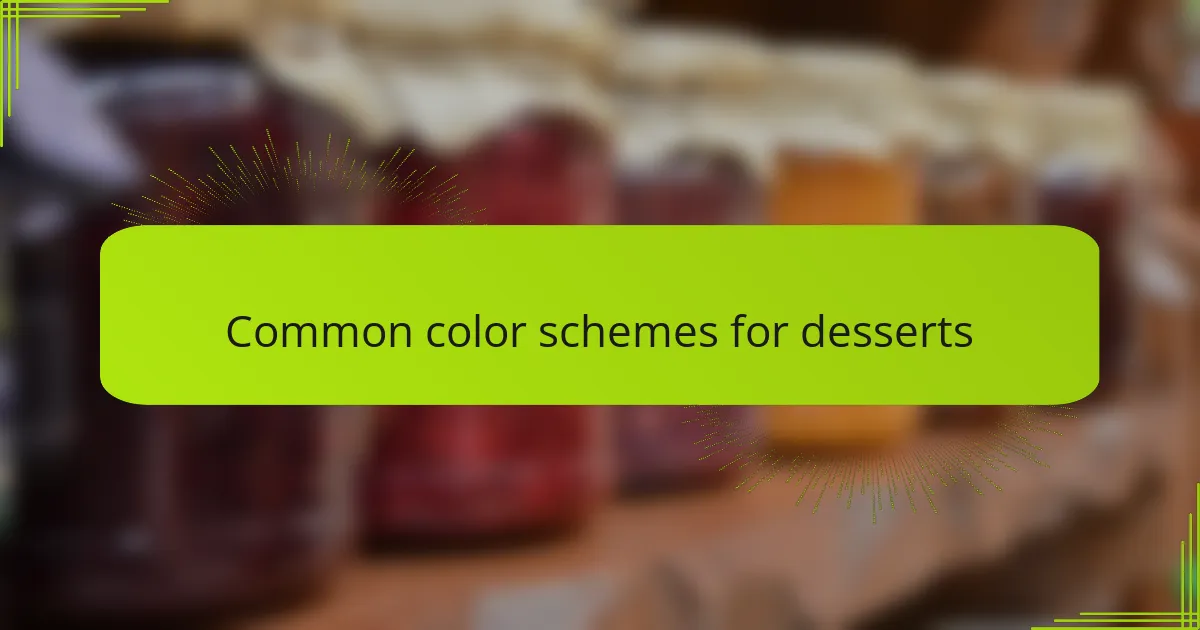
Common color schemes for desserts
When I think about common color schemes in desserts, neutrals paired with pops of vibrant color often come to mind first. For example, a classic vanilla cake adorned with bright red berries effortlessly catches attention without overwhelming the senses. Have you noticed how the contrast between soft tones and vivid accents makes the entire display feel balanced yet exciting?
Monochromatic schemes also fascinate me, especially when working with chocolate desserts. Using various shades of brown—from deep fudge to light caramel—creates a rich, inviting atmosphere. I’ve found that layering these subtle differences in color adds depth and sophistication, making the display feel luxurious without relying on flashy hues.
Sometimes, I lean into seasonal palettes, like warm oranges and deep reds during autumn or fresh greens and yellows in spring. It makes me wonder: do these familiar color groupings evoke memories tied to the seasons? From my experience, they definitely enhance the overall experience, connecting the dessert to more than just its flavor but also to the feelings we associate with that time of year.
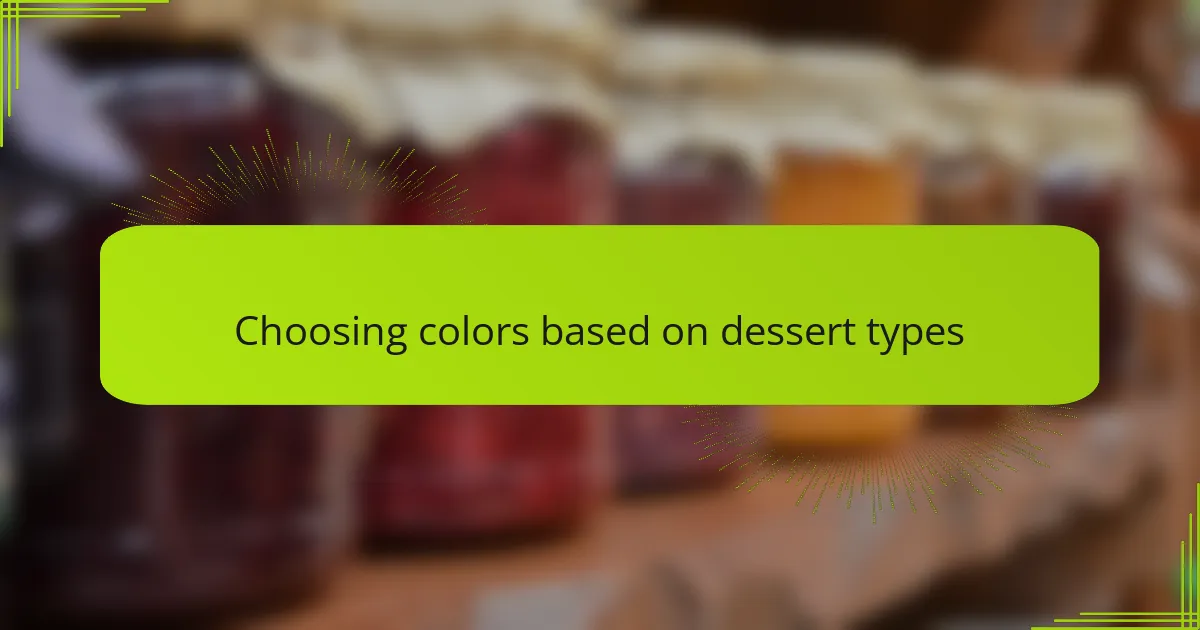
Choosing colors based on dessert types
Choosing colors based on dessert types feels like a natural extension of the flavors themselves. For instance, bright reds and deep purples perfectly highlight berry-based treats, making them look as fresh and vibrant as they taste. Have you ever noticed how a lemon tart’s sunny yellow instantly lifts your mood before the first bite? I find that matching colors to the natural ingredients not only enhances appeal but also tells a story about what’s to come.
When working with chocolate desserts, I tend to stick with rich, warm browns and creamy tans. These tones feel cozy and indulgent—almost like wrapping yourself in a soft blanket. It’s fascinating how certain color choices can amplify the dessert’s essence; don’t you think a dark chocolate ganache looks more tempting when set against lighter, complementary shades? I’ve observed that this subtle interplay helps guests anticipate the depth and richness of the flavors.
Fruit-based desserts invite a playful mix of colors, and I love using vibrant contrasts to emphasize freshness. Pairing a bright green pistachio macaron next to a vivid raspberry creates energy on the display that’s almost palpable. Isn’t it amazing how these juxtapositions evoke a sense of excitement and even nostalgia for summer picnics? Personally, I enjoy experimenting with these combinations to evoke emotions that transcend taste alone.
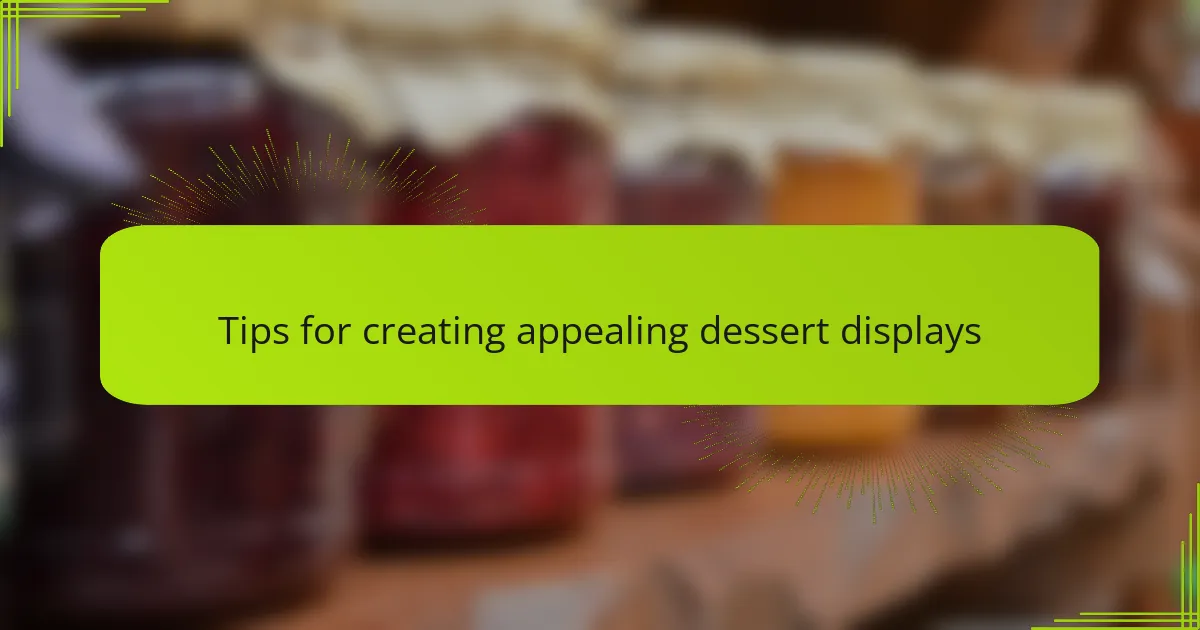
Tips for creating appealing dessert displays
When I’m setting up a dessert display, I always remind myself to think about balance. Too many loud colors can feel chaotic, while too few might look dull. Have you ever noticed how a well-curated color palette can actually guide your eyes across the table? From my experience, a carefully balanced mix draws people in and keeps them exploring every sweet detail.
One trick I often use is to layer desserts with varying heights and shapes to complement the color scheme. It’s not just about what colors you pick but how you arrange them that makes the display inviting. I find that this dynamic setup creates a natural rhythm, making the colors pop even more without feeling forced.
Sometimes, I ask myself if less is more when it comes to decoration. I’ve found that simple touches—like a few edible flowers or a light dusting of powdered sugar—can enhance colors without overshadowing the desserts themselves. Isn’t it amazing how these subtle details can elevate the entire presentation and make guests feel like they’re about to enjoy something truly special?
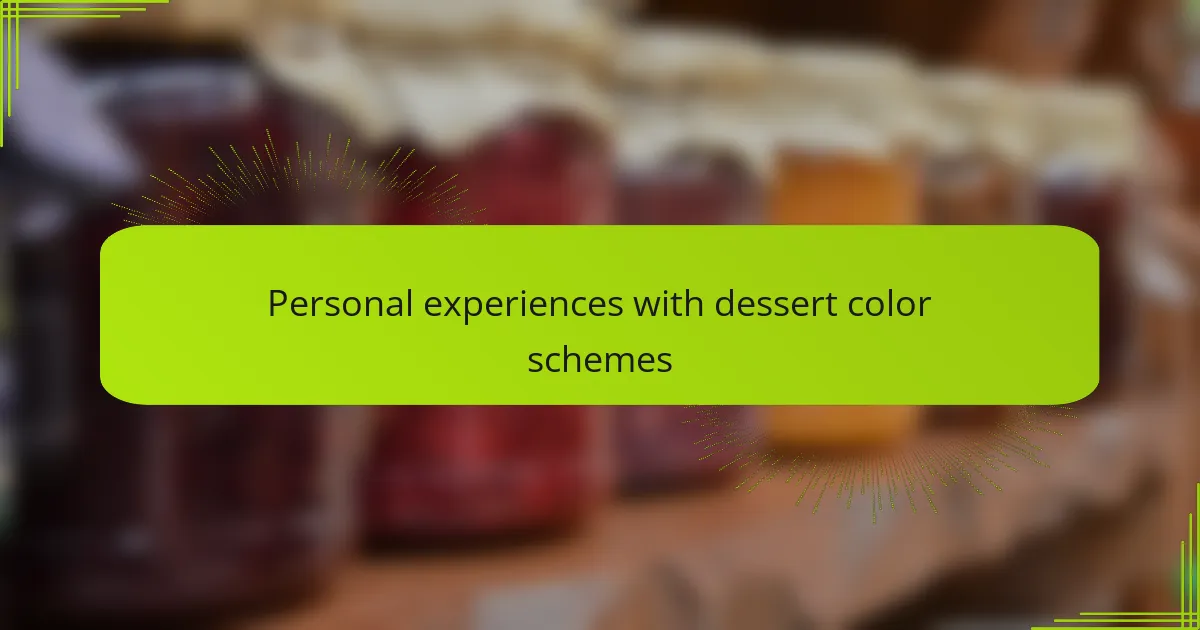
Personal experiences with dessert color schemes
I remember one time when I arranged a dessert table for a close friend’s birthday. I chose a mix of warm caramel tones and soft blush pinks, thinking it would create a cozy yet elegant vibe. Watching guests’ eyes light up and hearing their compliments made me realize how much these color choices can really shape the mood—even before anyone took a bite.
There was also a moment when I experimented with a bold, jewel-toned palette—deep sapphire blues and rich emerald greens—for a holiday party. Honestly, it felt risky, but the contrast brought a sense of drama and excitement that surprised even me. Have you ever felt that thrill when a color scheme breaks the usual mold and somehow pulls everything together perfectly? That’s the kind of creative spark I chase every time I design dessert displays.
Sometimes, I reflect on how certain colors make desserts feel more approachable. Pastels, for example, remind me of childhood celebrations—soft lavender cupcakes or minty green macarons evoke a gentle nostalgia. I wonder if others feel that same warm connection when they see these colors. For me, these personal associations make the whole dessert experience more than just taste; it becomes a moment wrapped in memory.
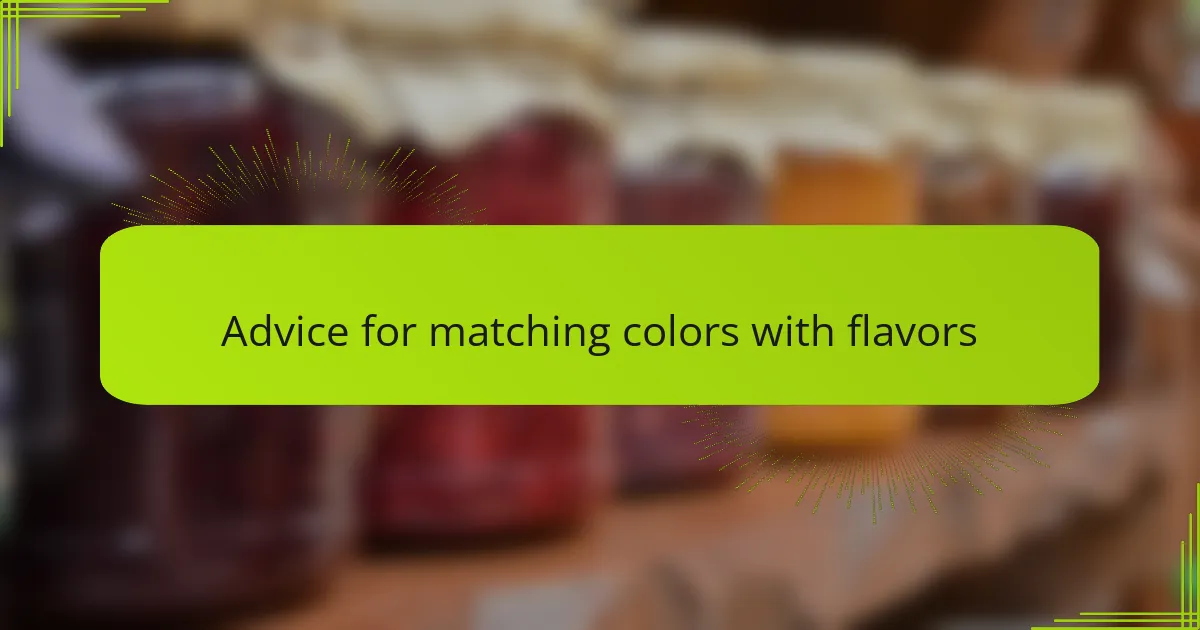
Advice for matching colors with flavors
When matching colors with flavors, I’ve found that letting the natural hues of the ingredients guide you is a reliable approach. For example, pairing the vibrant reds of strawberries with soft creams creates an inviting contrast that tells a story of freshness and sweetness without a single word spoken. Have you ever noticed how a dusty rose or pale peach can make a vanilla bean dessert feel more delicate and luxurious? It’s those subtle choices that, to me, elevate the entire tasting experience.
I also like to think about the emotional vibe I want the flavor to evoke when choosing colors. Rich, dark chocolates almost demand deep browns and burgundies, which I find add a cozy, almost comforting feel to the display. Meanwhile, lighter citrus or tropical flavors seem to sing best with bright yellows and lively greens—colors that make you anticipate a burst of sunshine and zest. Do you ever sense that the color palette can set your expectation even before you taste a mouthful? For me, that anticipation enhances every bite.
Sometimes, I get playful and experiment by pairing unexpected colors with flavors to surprise guests visually and gastronomically. Once, I matched pistachio’s subtle green with raspberry’s vivid pink on a single platter, which created a vibrant energy I hadn’t quite anticipated. That combination not only made the desserts pop but sparked conversations about how flavor and color can dance together. Have you tried any color-flavor pairings that made you see your desserts in a completely new light? Those moments keep my passion for dessert displays alive.
